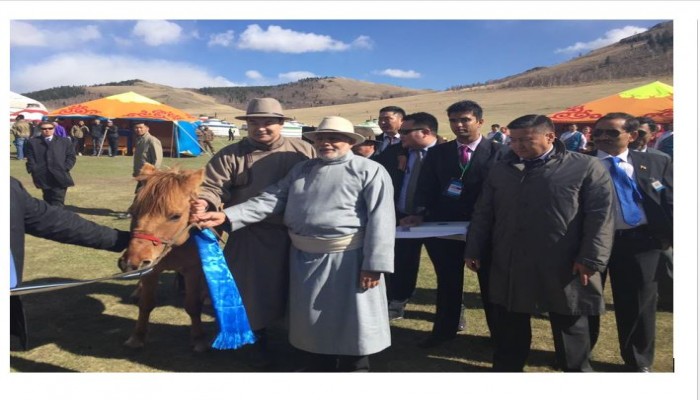India Mongolia Relations: Under the Dragon’s Scowl
- In Foreign Policy
- 09:45 AM, Jan 02, 2018
- Sanghamitra Purohit
Mongolia is a fascinating country. At 603,909 square miles, it is the 18th largest country in the world. The Second largest landlocked country after Kazakhstan and is known for its vast grasslands. It's also the most sparsely populated country. With a population of barely 3 million, it is yet to achieve its full potential in utilisation of natural resources and economic development.
India and Mongolia political relations go back a long way. Back in 1955, India was the first country outside the 'socialist' bloc to establish diplomatic ties with Mongolia. India had also pushed for Mongolia in the UN for a berth as well as in the Non-aligned movement (NAM).
However, when PM Narendra Modi took power in 2014, India's strategic expansion in Geopolitics and International relations saw a phenomenal, unprecedented revival. India was quick to acknowledge Mongolia's strategic location between Russia and China and extended open arms. Behind all the hugs, photo ops and selfies that the opposition and "eminent intellectuals " keep on ranting about, was PM Modi's well planned, strategically orchestrated and brilliantly executed policies of bilateral development, economic growth and mutually beneficial bonhomie. Put in a dash of Ajit Doval's foresight and bingo- We have a friend right in the middle of Russia and China.
Mongolia's biggest apparent disadvantage has been its location. It's landlocked between two giants who control its foreign trade, industrialisation and as a result, most of its foreign policies too. Currently, Mongolia exports almost all of its crude oil to China and imports petroleum products from Russia.
There has been rising unrest among the Mongolian public against China's clout over Mongolian trade and economy. As the nation was struggling with an economic slowdown the resentment grew deeper. The country also has a Buddhist majority population. When Mongolia welcomed Dalai Lama for a visit to its capital Ulan Bator, China expressed its displeasure by closing the food supply lines to Mongolia. This, however, angered the people even further and Mongolia reached out to India.
Earlier in 2017, Mongolia had a new president, Khaltmaa Battulga. He has been a fierce critic of China's domineering policies towards Mongolia and had campaigned relentlessly for His county's economic independence from China. Currently, china is Mongolia's largest trading partner and 90% of its exports go to China. Mongolia and its current president is striving very hard to change that.
India has not been reluctant in reciprocating. Right in the middle of the Doklam Standoff between India and China, where both countries were involved in a tense staring down contest, a prolonged muscle flexing on Indo-china border that grabbed global attention, India went ahead and invited Mr Khaltmaa Battulga for a visit to New Delhi in 2018. He has cordially accepted.
India and Mongolia had also been involved in a joint military exercise interestingly named as " The Nomadic Elephant". The name signifies a soft message. India's presence in Mongolia. Mongolia 's people consist of mostly Nomadic tribes. The same Nomadic tribes who gathered under a phenomenal conqueror named Genghis Khan in the thirteenth century whose descendants ruled over almost entire Europe and the middle east. Including China. The subtle messaging behind the name would not have been lost on the Chinese diplomats, much to their continual dismay. More so because the 12th iteration of the Joint military exercise was held in Vairengte, Mizoram. In the premises of the Indian Army's counterinsurgency and jungle warfare school. What was more important about the Nomadic Elephant 2017 was it has been held at the same time when Dalai Lama was visiting Tawang monastery in Arunachal Pradesh, an event that China had openly objected to.
PM Modi had announced a line of credit being opened to Mongolia during his visit in 2015. According to the plan, India would invest $700 million in a large-scale oil refinery and another 264 million $ for the development of oil pipelines. The massive financial assistance which has a 20-year duration will be charged at a nominal interest rate of 1.75 % and also the principal payments will be waived off for the first five years.
The refinery planned will have a massive impact on Mongolia's goal of economic independence from its two powerful neighbours, China and Russia. Mr G Ganbold, the Mongolian ambassador to India has said, "The refinery, will largely reduce or eradicate the dependency, at the same time, we are hoping it will save a lot of foreign exchange which can be utilised for other necessities".
After PM Modi's announcement of the plan, the Engineers India Limited (EEL) had been surveying the country for a detailed project report (DRP ) while playing out plans and constructions as the Mongolian refinery will act as the focal agency of the project. A report by Sputnik international has stated.
The same Sputnik international report gives the details of the refinery as having a massive 1.5 million metric tons of oil per year capacity. It will annually produce 560,000 tons of gasoline, 670,000 tons of diesel fuel and 107,000 tons of liquefied gas. According to estimations by experts involved this project single-handedly has the capacity to boost Mongolia's GDP further by 10 %.
It's interesting to note that the last time India Mongolia relations looked this strong was during the Atal Behari Vajpayee govt of 1999 - 2004. Both the I&T minister Mr Pramod Mahajan and the then Union Minister for HRD Dr Murli Manohar Joshi visited the country and established a long series of diplomatic, technological a d cultural and educational ties.
When the then Mongolian Prime Minister Nambaryn Enkhyabar visited India in January 2004, a number of treaties were signed ranging from the fields of Animal Health and diary, space science and biotechnology. India provides 40-50 scholarship slots to Mongolian students under ICCR and actives cooperates in cultural and educational advancements. Dr Joshi also oversaw the publication of key Indian literary works like Ramayana, Panchatantra, Shakuntala and Ritu Samhara and a lot more such works in the Mongolian language. The Atal Behari Centre for Excellence (ABVCE ) was established during Mr Pramod Mahajan's visit. It included an IT and communication technology centre and a credit line of 20 million USD for its development.
With PM Modi's relentless foreign policy overhaul, a fresh energy has been infused into India Mongolia bilateral relations. While the struggling, resources strapped nation is aspiring to liberate itself from the economic clutches of China, the current NDA govt is leaving no stones unturned in reciprocation and providing support to Mongolia and its people. Often asserting internationally that we won't be bullied by China.
Sources :
https://mea.gov.in/Portal/ForeignRelation/Mongolia_January_2017.pdf
https://sputniknews.com/asia/201712281060374485-india-to-construct-mongolia-refinery/
Disclaimer: The opinions expressed within this article are the personal opinions of the author. MyIndMakers is not responsible for the accuracy, completeness, suitability, or validity of any information on this article. All information is provided on an as-is basis. The information, facts or opinions appearing in the article do not reflect the views of MyindMakers and it does not assume any responsibility or liability for the same.







Comments